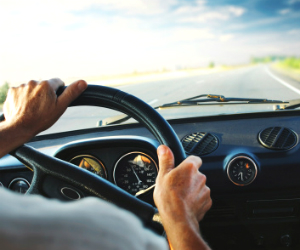Unraveling Mysteries of Safe Steering with Behavioral Science
 We may take it for granted, but exactly how we steer a car has remained a mystery to researchers for nearly 70 years.
We may take it for granted, but exactly how we steer a car has remained a mystery to researchers for nearly 70 years.
The prevailing theory for how we steer towards a target was initially developed by British researcher Arnold Tustin in 1947. Tustin was a pioneer in the engineering field of control theory which focuses on the interactions between humans and complex machines. According to Tustin’s theory for steering, drivers gently and continuously follow the road with the steering wheel in a linear fashion, known as “tracking in control theory.”
But newly published research from behavioral scientists Ola Benderius and Gustav Markkula of Chalmers University of Technology in Sweden suggests that steering is based on a surprising pattern of movements that resemble reaching.
“We were able to use the theory to explain what researchers had been trying to solve for a long time. This was the answer to the previously inexplicable jerkiness in the control signal. Rather than looking upon steering as continuously following the road, steering corrections seem to be applied in a very predetermined manner,” said Benderius.
While they were attending a lecture on neurocognition and the behavioral theory of reaching, Benderius and Markkula recognized the motor pattern of reaching as similar to the one they’d seen in the steering behavior in drivers.
When we move our hand from Point A to pick up something from Point B, the speed of the movement has a direct relationship with the distance — the longer the distance, the quicker the movement. Interestingly, the time for the movement is the same regardless of the distance.
“We immediately recognized this pattern from our measured steer signals,” says Benderius. “It was a bit of a eureka moment. Was it possible that this basic human behavior also controlled how we steer a car?”
Benderius and Markkula collected steering wheel behavior data from over 1,000 hours of driving simulator samples, including distracted drivers, sleep deprived drivers, and drivers executing evasive maneuvers.
In analyzing the data, the researchers developed a mathematical model that makes it possible to predict what drivers are going to do with the steering wheel before they do it.
“It is possible to predict how far the driver is going to turn the wheel, right when the person starts a wheel-turning movement. It’s like looking into the future,” said Benderius.
This discovery, presented at the Proceedings of the Human Factors and Ergonomics Society 58th Annual Meeting, could lead to the development of automated safety systems for cars that can enhance driving safety.
For example, as a fatigued driver begins to run off the side of the road, he or she might dangerously overcorrect the steering wheel leading to an accident. In the future cars may include support systems that can identify these misjudgments and intervene before they happen, potentially preventing serious accidents.
“Control behavior has traditionally been studied on the basis of control theory and technical systems,” says Benderius. “If it is instead studied on the basis of neuroscience with focus on the human, an entire new world opens up. This could push the research field in an entirely different direction.”
Reference
Benderius, O. & Markkula, G. (2014, October). Evidence for a fundamental property of steering. Paper presented at the Human Factors and Ergonomics Society 58th Annual Meeting, Chicago, IL.





APS regularly opens certain online articles for discussion on our website. Effective February 2021, you must be a logged-in APS member to post comments. By posting a comment, you agree to our Community Guidelines and the display of your profile information, including your name and affiliation. Any opinions, findings, conclusions, or recommendations present in article comments are those of the writers and do not necessarily reflect the views of APS or the article’s author. For more information, please see our Community Guidelines.
Please login with your APS account to comment.